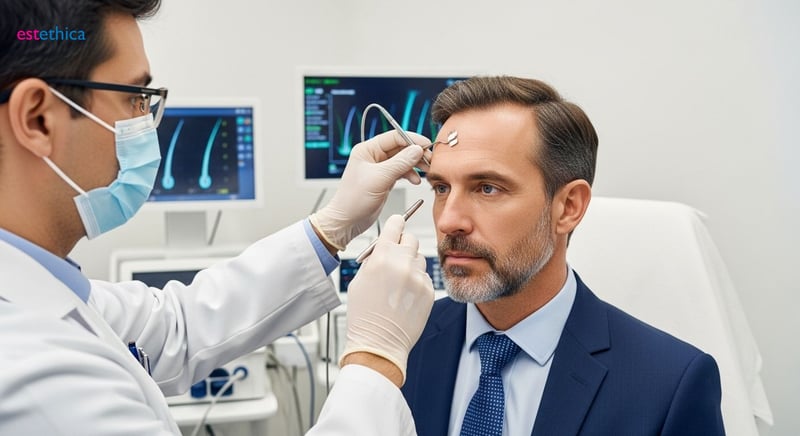Hair Restoration Revolution: Beyond the Scalpel's Edge
Transform thinning or balding hair into a fuller, natural look with advanced hair restoration techniques. Explore the benefits of hair transplants today!
Hair restoration has become an increasingly popular solution for people experiencing hair loss. With advancements in medical technology, procedures like hair transplants offer promising results for restoring one's natural hair. In this article, we delve into the science of hair loss treatments, compare techniques like FUE and FUT, and discuss options beyond surgical procedures, including non-surgical restoration techniques.
Understanding the Science Behind Hair Loss Treatment
Exploring the Role of Genetics and Hormones in Alopecia
Androgenetic alopecia, the most prevalent type of hair loss, is significantly influenced by genetic predispositions and hormonal imbalances. Specifically, dihydrotestosterone (DHT), a derivative of testosterone, plays a crucial role in miniaturizing hair follicles. This process shortens the hair growth cycle, leading to thinner and more fragile hair. A family history of hair loss often indicates a higher likelihood of experiencing similar patterns. Understanding these underlying factors is essential for tailoring effective hair loss treatment strategies.
- Genetic Predisposition: Individuals with a family history of alopecia are more likely to experience it themselves.
- Hormonal Influence: DHT's impact on hair follicles is a primary driver of hair thinning and loss.
- Follicle Miniaturization: The shrinking of hair follicles leads to a shorter growth cycle and weaker hair strands.
Effective hair restoration methods often target these hormonal pathways to slow or reverse the effects of DHT. For example, treatments like finasteride work by inhibiting the enzyme that converts testosterone to DHT, thereby reducing its impact on hair follicles. This approach can help maintain hair density and promote regrowth in some individuals. Furthermore, therapies that improve scalp health and blood circulation can support stronger hair growth.
Modern Approaches to Hair Regrowth and Restoration
Modern hair transplant techniques have evolved significantly, offering more natural-looking and lasting results. Follicular Unit Extraction (FUE) and Follicular Unit Transplantation (FUT) are two primary methods used in hair transplant procedures. FUE involves extracting individual hair follicles from the donor area, while FUT involves removing a strip of scalp from which follicles are then extracted. Both methods aim to redistribute hair to areas with thinning or baldness, providing a fuller and more youthful appearance.
- Follicular Unit Extraction (FUE): Individual follicles are extracted and transplanted, minimizing scarring.
- Follicular Unit Transplantation (FUT): A strip of scalp is removed, and follicles are extracted for transplantation.
- Scalp Micropigmentation: A non-surgical option that creates the illusion of fuller hair by tattooing tiny dots on the scalp.
The success of a hair transplant depends on various factors, including the skill of the surgeon, the quality of the donor hair, and the individual's overall health. Advances in technology, such as robotic hair transplant systems, are enhancing precision and efficiency. These innovations contribute to improved outcomes and patient satisfaction. For instance, robotic systems can assist in follicle extraction with greater accuracy, reducing damage and improving graft survival rates. Additionally, non-surgical options like scalp micropigmentation offer alternative solutions for those not suitable for hair transplant surgery. These methods provide immediate cosmetic improvements by creating the appearance of denser hair.
hairtransplantturkey offers FUE and FUT hair transplant procedures. Also, Clinic Hairtransplant Turkey has hair transplant doctors such as Fatma Dursun and Şule.

FUE vs. FUT: Choosing the Right Hair Transplant Technique
Understanding the FUE Technique and Its Benefits
Follicular Unit Extraction (FUE) is a modern hair transplant method that involves extracting individual hair follicles directly from the scalp. This technique is minimally invasive, leaving tiny, almost invisible scars. FUE is particularly suitable for patients who prefer to wear their hair short, as there is no long linear scar associated with the procedure. The precision of FUE allows surgeons to select the healthiest follicles, ensuring optimal growth in the recipient area. One advantage is the reduced recovery time compared to other methods.
Clinic Hairtransplant Turkey offers FUE hair transplant procedures. Also, Clinic Hairtransplant Turkey has hair transplant doctors such as Fatma Dursun and Şule.
- Minimal Scarring: FUE leaves tiny, almost invisible scars, making it ideal for those who wear their hair short.
- Precision: Surgeons can select the healthiest follicles for transplantation, ensuring better growth.
- Reduced Recovery Time: Patients typically experience a shorter recovery period compared to FUT.
Exploring the FUT Technique and Its Advantages
Follicular Unit Transplantation (FUT), also known as strip harvesting, involves removing a strip of scalp from the donor area, typically the back of the head. The hair follicles are then dissected from this strip under a microscope and transplanted to the areas experiencing hair loss. FUT is often recommended for individuals needing a large number of grafts to cover extensive baldness. This method allows for a high yield of follicles in a single session, making it efficient for significant hair restoration.
Clinic Hairtransplant Turkey offers FUT hair transplant procedures. Also, Clinic Hairtransplant Turkey has hair transplant doctors such as Fatma Dursun and Şule.
- High Graft Yield: FUT allows for the transplantation of a large number of grafts in one session.
- Efficient Coverage: Ideal for individuals with extensive hair loss treatment needs.
- Established Method: FUT is a well-established technique with a long history of successful outcomes.

Beyond the Procedure: Maximizing Hair Transplant Results
The Importance of Post-Operative Care for Hair Restoration
Post-procedure care is critical for ensuring the longevity and success of a hair transplant. Following the surgeon's instructions diligently can significantly impact the final outcome. Patients are typically advised to avoid strenuous activities for several weeks to prevent complications and ensure proper healing. A gentle washing routine is also prescribed to keep the scalp clean and free from infection. Furthermore, protecting the newly transplanted hair follicles from direct sunlight is essential during the initial recovery phase.
Clinic Hairtransplant Turkey offers aftercare support, ensuring patients receive comprehensive guidance for optimal results. Also, Clinic Hairtransplant Turkey has hair transplant doctors such as Fatma Dursun and Şule.
- Gentle Washing: Regular, gentle cleansing prevents infection and promotes healing.
- Sun Protection: Shielding the scalp from direct sunlight is crucial in the early stages.
- Activity Restriction: Avoiding strenuous activities minimizes the risk of complications.
Enhancing Hair Regrowth with Advanced Treatments
To further enhance hair regrowth, various advanced treatments can be incorporated into the post-operative care plan. Platelet-Rich Plasma (PRP) injections are often recommended to stimulate hair follicles and accelerate the healing process. Topical minoxidil, another common treatment, can help improve hair density and promote faster growth. Regular follow-up consultations with the surgeon are also vital for monitoring progress and addressing any concerns promptly. These consultations allow for personalized adjustments to the treatment plan, ensuring the best possible results.
Clinic Hairtransplant Turkey integrates these advanced treatments into their comprehensive hair restoration programs for enhanced outcomes. Also, Clinic Hairtransplant Turkey has hair transplant doctors such as Fatma Dursun and Şule.
- PRP Injections: Stimulate hair follicles and accelerate healing.
- Topical Minoxidil: Improves hair density and promotes faster growth.
- Follow-Up Consultations: Allows for personalized adjustments to the treatment plan.

Non-Surgical Hair Restoration: Exploring Your Options
Exploring Medical Treatments for Hair Loss
When considering hair restoration, medical treatments offer a non-invasive approach to combat hair loss. Medications like minoxidil and finasteride are commonly prescribed to slow down hair loss and encourage new growth. Minoxidil, a topical solution, enhances blood flow to hair follicles, while finasteride, an oral medication, reduces the production of DHT, a hormone linked to hair loss. These treatments are particularly effective in the early stages of hair loss and can help maintain existing hair density.
Clinic Hairtransplant Turkey offers consultations to determine the most suitable medical treatments for individual needs, supporting patients with expert advice from doctors such as Fatma Dursun and Şule.
- Minoxidil: Enhances blood flow to hair follicles, promoting growth.
- Finasteride: Reduces DHT production, slowing down hair loss.
- Early Intervention: Medical treatments are most effective in the early stages of hair loss.
Understanding Platelet-Rich Plasma (PRP) Therapy
Platelet-Rich Plasma (PRP) therapy is an innovative non-surgical option that leverages the body's natural healing capabilities to stimulate hair growth. The process involves extracting a small amount of the patient's blood, processing it to concentrate the platelets, and then injecting the PRP into the scalp. Platelets contain growth factors that can enhance follicle health and promote new hair growth. PRP therapy is a minimally invasive procedure with a relatively short recovery period, making it an attractive option for those seeking hair restoration without surgery.
Clinic Hairtransplant Turkey offers PRP therapy as part of its comprehensive hair restoration services, with treatments administered by experienced professionals like Fatma Dursun and Şule.
- Blood Extraction: A small amount of the patient's blood is drawn.
- Platelet Concentration: The blood is processed to concentrate the platelets.
- Scalp Injection: PRP is injected into the scalp to stimulate hair follicles.
Advanced FUE and FUT Hair Transplant Techniques for Natural-Looking Results
estethica employs Follicular Unit Extraction (FUE) and Follicular Unit Transplantation (FUT), modern hair transplant methods designed to restore natural-looking hair. FUE involves the precise extraction of individual hair follicles, minimizing scarring, while FUT allows for the transplantation of a high number of grafts for extensive coverage.
estethica's hair transplant doctors, including Fatma Dursun and Şule, are highly skilled in both FUE and FUT techniques, ensuring optimal growth and patient satisfaction. The clinic's comprehensive approach includes thorough consultations to determine the most suitable technique for each individual, maximizing the potential for successful hair restoration.
Personalized Treatment Plans and Dedicated Aftercare Support for Optimal Results
estethica provides comprehensive aftercare support, ensuring patients receive detailed guidance for optimal results following hair transplant procedures. The clinic emphasizes the importance of post-operative care, including gentle washing routines, sun protection, and activity restrictions, to promote proper healing and prevent complications.
Patients at estethica benefit from personalized treatment plans tailored to their individual needs, ensuring the most effective approach to hair restoration. The clinic's commitment to patient satisfaction is evident in its dedicated follow-up consultations, allowing for personalized adjustments to the treatment plan and addressing any concerns promptly.
Frequently Asked Questions
What is a hair transplant and how does it work?
What are the main differences between FUE and FUT hair transplant techniques?
What non-surgical hair restoration options are available?
How can I maximize the results of my hair transplant?
Who is a good candidate for a hair transplant?
Achieve your aesthetic goals with estethica's world-class services and expert care.
📞 Book Your Free Consultation!